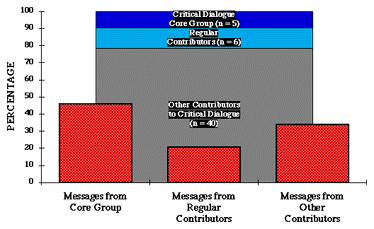

|
GROUP / Name |
|
|
|
(0 - 3) |
|
5 MEMBERS OF CRITICAL DIALOGUE CORE GROUP |
24-40 each;156 total |
45.7% |
5.13 avg (for 4) |
2.28 avg |
|
1. Gregory |
|
|
|
|
|
2. Ronald |
|
|
|
|
|
3. Buff |
|
|
|
|
|
4. Marvin |
|
|
|
|
|
5. Hillary |
|
|
|
|
|
6 REGULAR CONTRIBUTORS TO CRITICAL DIALOGUE |
10-13 each;70 total |
20.5% |
4.0 avg |
2.38 avg |
|
40 OTHER CONTRIBUTORS TO CRITICAL DIALOGUE |
1-8 each;115 total |
33.7% |
3.82 avg |
1.97 avg |
|
TOTAL (n = 51) |
341 |
100% |
3.99 avg |
2.05 avg |
Focusing just on messages categorized as critical dialogue (higher-order discussion primarily about social and political issues or dorm community issues) we find that, as with the e-mail list as a whole (see 11: "Core Group," "Regular," and "Lurker" Participation by Student Residents), a small core group of heavy participators can be identified. In this case, only 5 people contributed 46% of the critical dialogue messages; 4 of the 5 were male (a similar gender pattern to the whole list -- see 13: Core Group Participation by Gender). Gregory (40 messages or nearly 12%) and Ronald (35 messages or over 10%) were the leading contributors to critical dialogue. Hillary, the leading contributor to the e-mail list as whole, contributed the same proportion (7%) of messages to critical dialogue as she did to the list as a whole. Although the core group was responsible for a disproportionate amount of the critical dialogue, I would emphasize the following points in suggesting that the value of critical dialogue was more widespread for the community: